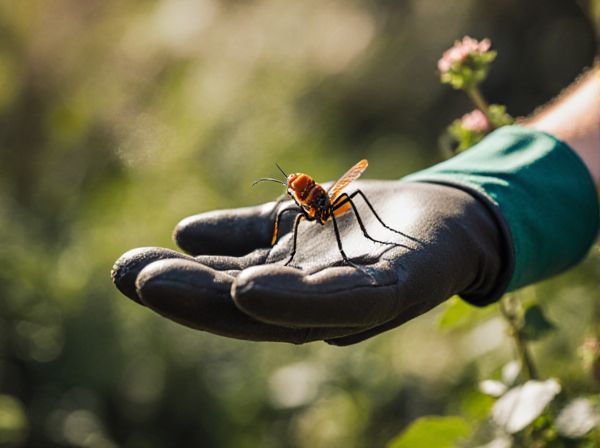
Predatory insects vs Parasitic wasps Illustration
Predatory insects actively hunt and consume multiple pests, providing immediate population control in gardens and crops. Parasitic wasps target specific hosts by laying eggs inside or on pests, leading to a natural and sustained reduction of pest populations over time. Both biological control agents play crucial roles in integrated pest management by minimizing chemical pesticide use and promoting ecological balance.
Table of Comparison
| Feature | Predatory Insects | Parasitic Wasps |
|---|---|---|
| Definition | Insects that hunt and consume other pests | Wasps that lay eggs inside or on host pests, leading to host death |
| Examples | Ladybugs, Lacewings, Assassin bugs | Braconid wasps, Ichneumonid wasps, Trichogramma |
| Mode of Action | Active hunting and direct consumption | Parasitism via egg deposition in hosts |
| Target Pest Types | Aphids, caterpillars, scales | Caterpillars, beetle larvae, aphids |
| Effectiveness | Immediate pest population reduction | Long-term pest control through lifecycle interruption |
| Environmental Impact | Natural and eco-friendly pest control | Species-specific with minimal environmental disruption |
| Use in Integrated Pest Management (IPM) | Widely used for broad pest control | Targeted biocontrol in IPM programs |
Introduction to Beneficial Insects in Garden Pest Control
Predatory insects such as ladybugs and lacewings actively hunt and consume a variety of garden pests including aphids and caterpillars, providing direct pest population control. Parasitic wasps lay their eggs inside or on pest insects like aphids and caterpillars, with emerging larvae feeding on the host, effectively reducing pest numbers through biological parasitism. Both predatory insects and parasitic wasps play crucial roles as beneficial insects, enhancing integrated pest management by naturally suppressing harmful pest populations in gardens.
Predatory Insects: Nature’s Pest Management Team
Predatory insects, including lady beetles, lacewings, and assassin bugs, serve as an essential component of natural pest management by actively hunting and consuming harmful pests such as aphids, caterpillars, and whiteflies. These insects contribute significantly to maintaining ecological balance in agricultural and garden settings by reducing the reliance on chemical pesticides and supporting sustainable pest control methods. Their role in integrated pest management (IPM) programs highlights their efficiency in targeting a wide range of pest species, ensuring healthier crops and improved biodiversity.
Parasitic Wasps: Silent Warriors Against Garden Pests
Parasitic wasps act as silent warriors against garden pests by laying their eggs inside or on pest insects, effectively controlling populations like aphids, caterpillars, and whiteflies. These wasps belong to families such as Braconidae and Ichneumonidae, specializing in precise biological pest control without harming beneficial pollinators or plants. Unlike predatory insects that consume pests directly, parasitic wasps rely on parasitism to reduce pest numbers sustainably, enhancing garden health through natural ecological balance.
Key Differences: Predatory Insects vs. Parasitic Wasps
Predatory insects actively hunt and consume multiple prey throughout their lifecycle, providing immediate pest reduction by targeting various pest species such as aphids and caterpillars. Parasitic wasps, in contrast, lay their eggs inside or on a single host insect, with the developing larvae gradually killing the host, making them highly specific and efficient biological control agents. This fundamental difference in feeding strategy and host interaction drives their distinct roles in integrated pest management systems.
Common Types of Predatory Insects for Gardens
Common types of predatory insects in gardens include lady beetles, lacewings, and assassin bugs, all of which actively hunt and consume pest insects like aphids, mites, and caterpillars. Lady beetles, especially the seven-spotted ladybird, are well-known for their voracious appetite for aphids, while green lacewing larvae target soft-bodied pests with precision. Assassin bugs employ stealth and speed to capture a diverse range of garden pests, making them crucial biological controls alongside parasitic wasps that specialize in parasitizing pest larvae.
Top Parasitic Wasps Used in Biological Control
Top parasitic wasps used in biological control include Trichogramma, Encarsia, and Aphidius species, renowned for their effectiveness against various agricultural pests. Trichogramma targets lepidopteran eggs, while Encarsia is employed against whiteflies, and Aphidius parasitizes aphids. These parasitic wasps enhance pest management by naturally reducing pest populations, minimizing the need for chemical pesticides.
How Predatory Insects and Parasitic Wasps Target Pests
Predatory insects, such as lady beetles and lacewings, actively hunt and consume pest insects like aphids and caterpillars, directly reducing pest populations. Parasitic wasps lay their eggs inside or on the bodies of pest insects, and their larvae consume the host from within, effectively controlling pests like whiteflies and mealybugs. Both natural enemies play crucial roles in integrated pest management by targeting different pest life stages to minimize crop damage.
Advantages and Limitations of Each Method
Predatory insects efficiently reduce pest populations by consuming multiple prey, providing rapid and visible pest control but may struggle with pest species that are hidden or protected. Parasitic wasps offer targeted control by laying eggs inside pests, leading to pest population decline from within and minimal non-target impact; however, their slower action and dependency on host availability can limit immediate effectiveness. Using both methods in integrated pest management enhances pest suppression by combining the broad predation of insects with the specificity of parasitic wasps.
Integrating Predatory Insects and Parasitic Wasps in Your Garden
Integrating predatory insects and parasitic wasps in your garden enhances natural pest control by targeting different pest species effectively. Predatory insects like ladybugs consume aphids and scale insects, while parasitic wasps lay eggs inside pest larvae, disrupting their life cycle. Combining these biological agents reduces chemical pesticide reliance, promotes biodiversity, and maintains a balanced garden ecosystem.
Tips for Attracting and Sustaining Beneficial Insects
Planting a diverse array of native flowering plants and herbs such as dill, fennel, and yarrow encourages predatory insects and parasitic wasps by providing nectar and pollen resources essential for their survival. Maintaining habitat complexity with mulches, ground covers, and undisturbed areas offers shelter and breeding sites critical for sustaining beneficial insect populations. Avoiding broad-spectrum insecticides preserves these natural pest controllers, enhancing biological pest management in gardens and agricultural fields.
Predatory insects vs Parasitic wasps Infographic

 gardendif.com
gardendif.com